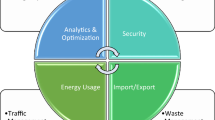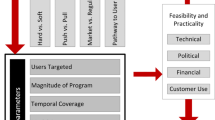Abstract
This paper describes a method for using location data to optimize the routing of pavement data collection vehicles. In much of the developed world, pavement testing is performed on a regular basis; the pavement testing data, in turn, serves as input to Pavement Management Systems. Currently, in the United States of America, state departments of transportation plan this data collection work by providing the list of roads that must be tested and then leave the routing of the vehicles to the equipment operators who typically execute the work in an ad hoc manner. This study presents the processes required to code the list of roads for testing, select appropriate hotels in the region of testing, and apply a Traveling Salesman Problem with Hotel Stops model to derive a route. Applying the processes to a case study shows significant cost savings associated with this method of roadway testing, as opposed to the current ad hoc methods.


Similar content being viewed by others
References
Castro M, Sörensen K, Vansteenwegen P, Goos P (2013) A memetic algorithm for the travelling salesperson problem with hotel selection. Comput Oper Res 40(7):1716–1728
Castro M, Sörensen K, Vansteenwegen P, Goos P (2015) A fast metaheuristic for the travelling salesperson problem with hotel selection. 4OR 13(1):15–34
Cormen TH (2009) Introduction to algorithms. MIT press, Cambridge
Dror M (2000) Arc routing: theory, solutions and applications. Springer, Heidelberg
Eiselt HA, Gendreau M, Laporte G (1995) Arc routing problems, part I: the Chinese postman problem. Oper Res 43(2):231–242
Golabi K, Kulkarni RB, Way GB (1982) A statewide pavement management system. Interfaces 12(6):5–21
Google (2015) Google® maps distance matrix api. [API] available from: https://developers.google.com/maps/documentation/distance-matrix/. Accessed 25 Jan 2017
Google (2016) Google® maps geocoding api. [API] available from: https://developers.google.com/maps/documentation/geocoding/start. Accessed 25 Jan 2017
Gurobi Optimization I (2015) Gurobi optimizer reference manual. http://www.gurobi.com. Accessed 13 Mar 2017
Hurwitz C (1994) Gnu tsp_solve v. 1.3.6. [software]. Available from: http://www.cs.sunysb.edu/~algorith/implement/tsp/implement.shtml. Accessed 25 Jan 2017
Jang W (2011) Optimizing winter/snow removal operations in MoDOT St. Louis District - includes outcome based evaluation of operations. Missouri Department of Transportation, Missouri
Medury A, Madanat S (2013) Simultaneous network optimization approach for pavement management systems. J Infrastruct Syst 20(3):04014010
Office of the Legislative Auditor (1995) Snow and ice control. a best practices review. Report no. 95-06. Tech. rep., Minnesota Department of Transportation http://www.auditor.leg.state.mn.us/ped/pedrep/9506-all.pdf. Accessed 13 Mar 2017
Perrier N, Langevin A, Campbell J (2007a) A survey of models and algorithms for winter road maintenance. Part III: vehicle routing and depot location for spreading. Comput Oper Res 34:211–257
Perrier N, Langevin A, Campbell J (2007b) A survey of models and algorithms for winter road maintenance. Part IV: vehicle routing and fleet sizing for plowing and snow disposal. Comput Oper Res 34:258–294
Ralyté J, Khadraoui A, Léonard M (2015) Designing the shift from information systems to information services systems. Bus Inf Syst Eng 57(1):37–49
Srour FJ, van de Velde S (2013) Are stacker crane problems easy? A statistical study. Comput Oper Res 40(3):674–690
Tsai YJ, Lai J (2002) Framework and strategy for implementing an information technology-based pavement management system. Transp Res Rec 1816:56–64. doi:10.3141/1816-07
Vansteenwegen P, Souffriau W, Sörensen K (2012) The travelling salesperson problem with hotel selection. J Oper Res Soc 63(2):207–217
Zandbergen PA (2008) A comparison of address point, parcel and street geocoding techniques. Comput Environ Urban Syst 32(3):214–232
Author information
Authors and Affiliations
Corresponding author
Additional information
Accepted after two revisions by the editors of the special issue.
Appendix A: Mathematical Formulation of Route Optimization Problem
Appendix A: Mathematical Formulation of Route Optimization Problem
In the language of graph theory, the authors define a graph G comprised of arcs, A, vertices V, and edges E. The arcs must be traversed, while the edges may, optionally, be used as necessary to travel between non-adjacent arcs. This relatively straight forward problem is complicated by the fact that drivers are bound by hours-of-service regulations that require a rest period after a period of 8 h of work. If overtime work is allowed, then rest is permitted after a minimum of 8 h and before a maximum of 12 h. Then, the drivers may either use a hotel or return to the home city of the testing agency to rest for the evening. Determining the tours through all arcs that minimize costs, which are a combination of drive time and hotel stays, is the objective of this problem.
To achieve this, the arcs (the sections that must be tested) are reduced to nodes. A node for the depot and nodes for the hotels that may be used within the route are also specified. Multiple copies of the depot and hotel nodes may be included in the model to allow for multiple trips to/from the depot and multiple stays at a specific hotel. Then the problem is formulated as a routing problem in which the goal is to construct a set of least cost cycles passing through all nodes. Given this problem description, the following notation for the parameters is designated.
- D :
-
the set of depot copies included to permit as many trips home as necessary
- H :
-
the set of hotels (including copies of hotels as necessary)
- J :
-
the set of jobs (i.e. sections for testing)
- N :
-
the set of all nodes, which is: \(D \cup H \cup J\)
- \(t_{ij}\) :
-
the time required to travel from node i to node j
- F :
-
the set of sections that are farther than a set threshold, \(\theta\), away. Mathematically, \(F = \left\{ (i,j)|t_{ij} \ge \theta \right\}\). Section pairs that are more than \(\theta\) units apart require additional equipment setup time upon arrival
- \(s_{j}\) :
-
the time required to setup the equipment to test a section \(j \in J\)
- \(c_{h}\) :
-
the cost of staying in hotel \(h \in H\)
- \(\mu\) :
-
the cost of mobilization – that is the cost per unit time to travel to a node in the test equipment, excluding operator wages
- \(\tau\) :
-
the cost of testing – that is the cost per unit time to setup or test a segment, excluding operator wages
- \(\omega\) :
-
the operator’s wages per unit time when not in overtime
- \(\Omega\) :
-
the operator’s wages per unit time when in overtime
- W :
-
the length of the working day; in our case, 8 h or 480 min
- \(\sigma\) :
-
the allowable amount of overtime; may be 0 (indicating no overtime allowed) up to 4 h
- M :
-
a large number set to be \(W+2\cdot \max _{i,j} \{d_{ij}\}\)
Given the problem of interest, the following three variables are specified:
- \(x_{ij}\) :
-
a binary variable indicating whether arc (i, j) is used in the final routing; \(i,j \in N\)
- \(\delta _{i}\) :
-
a continuous variable designating the time of arrival at the location of node \(i \in N\)
- \(\eta _{i}\) :
-
an integer variable designating the day on which a node \(i \in N\) is used
Using the notation described above, a MIP is formulated as follows:
such that
In words, the objective of this model, in Eq. (1), is to minimize the total cost associated with traveling between jobs, hotels, and the depot, the cost of setting up to test disparate road sections, the cost of staying in hotels, the cost of paying each day’s regular wages and the cost of overtime wages. In this formulation a full day of wages are paid if any testing occurred on that day. However, if one prefers to charge for only the time involved testing or mobilizing on any one day, the term \(\omega W\) may be replaced by \(\omega t_{ij}\) within the fourth summation of the objective. This objective is subject to the following constraints:
-
Equation (2) Each job and hotel/depot node must have one and only one arc leaving.
-
Equation (3) Each job and hotel/depot node must have one and only one arc entering.
-
Equation (4) The first copy of the depot node must have one route departing from it to a job. (All other copies of the depot node may be left unused.)
-
Equation (5) No jobs can be rejected.
-
Equation (6) If node j is the first node assigned following a stay in hotel/depot i, then the arrival time to j (\(\delta _{j}\)) must be later than the time required to travel from the hotel/depot to the starting location of demand j.
-
Equation (7)–(8) If node j follows job i then the arrival time to node j must be later than the arrival time to job i plus the time required to serve job i plus the time required to travel between job i and node j; if, however, \(x_{ij} = 0\), then the arrival time to job j is unconstrained. Furthermore, if the sections are within \(\theta\) of each other, then the setup time may be ignored.
-
Equation (9) The arrival time to job j must be during the working day and at least before the time that serving job j would no longer be feasible with allowable overtime of \(\sigma\)
-
Equation (10) The arrival time at a hotel or back at the depot must be after the end of the working day and before a point where it would be considered overtime.
-
Equations (11)–(13) The day increases by one when a hotel or depot is used.
-
Equation (14) \(\delta _{i}\) is a positive real number.
-
Equation (15) \(\eta _{i}\) is a positive real number.
-
Equation (16) \(x_{ij}\) is binary.
Rights and permissions
About this article
Cite this article
Bazi, G., El Khoury, J. & Srour, F.J. Integrating Data Collection Optimization into Pavement Management Systems. Bus Inf Syst Eng 59, 135–146 (2017). https://doi.org/10.1007/s12599-017-0466-4
Received:
Accepted:
Published:
Issue Date:
DOI: https://doi.org/10.1007/s12599-017-0466-4




